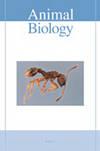海洋虾虎鱼矢状耳石的形态学研究(虾虎鱼目:虾虎鱼目)
IF 0.9
4区 生物学
Q2 ZOOLOGY
引用次数: 0
摘要
鱼类在种内交流中面临的挑战导致了它们感觉系统不同部分的适应,包括听觉系统。有证据表明,每个物种的感觉能力都是特定的。耳石是硬骨鱼听觉系统的一部分,在维持平衡和听觉方面起着重要作用。根据以往的研究,耳石的形态变化是遗传和环境因素(如深度、饮食、游泳和底物)共同作用的结果。在本研究中,我们重点解释了:(1)作为一种既生活在水生环境中又生活在陆地环境中的动物,虾虎鱼耳石的形态变化;(2)利用这种形态变化来区分虾虎鱼;(3)通信系统如何适应当地环境。对6种虾虎鱼的矢状耳石进行了提取和描述。下一步,我们使用几何形态计量学方法和形状指数对矢状耳石进行了研究。在所研究的虾虎鱼中,矢状面最常见的特征是中间和内侧沟以及没有清晰的喙和反喙。两种检测方法的比较表明,几何形态测量方法能够检测到虾虎鱼物种之间的细微差异。此外,生活方式和视力似乎会影响听觉系统的效率,尤其是耳石的形状。例如,waltoni(一种与其他鱼类不同,大部分时间都在水里度过的鱼类)的耳石形状似乎是适应陆地和水的结果。本文章由计算机程序翻译,如有差异,请以英文原文为准。
Morphological surveys of the sagittal otolith of marine gobiid fish (Teleostei: Gobioidei)
The challenges fish face in intraspecific communication has resulted in adaptation in different parts of their sensory system, including the auditory system. Evidence suggests that the sensory capability is specific for each species. The otolith is a part of the auditory system of teleost fish, and plays an important role in maintaining balance and in hearing. According to previous research, the morphological variation of otoliths is a result of a synergy between genetic and environmental factors such as depth, diet, swimming, and substrates. In this research we focused to explain (1) morphological variations of the otolith of gobiid fish as an animal inhabiting both aquatic and terrestrial environments; (2) the use of this morphological variations for distinguishing gobiid fish; and (3) how communication systems adapt to the local environment. The sagittal otoliths of six species of gobiid fish were extracted and described. In the next step, we studied the sagittal otoliths using the geometric morphometrics method and shape indices. The most common characteristics of the sagitta in the studied gobies fish were the median and mesial sulcus and the absence of a clear rostrum and antirostrum. A comparison between the examined methods showed that the geometric morphometric approach was able to detect the subtle differences between gobies species. Moreover, it seems that lifestyle and vision could affect the efficiency of the auditory system, in particular the otolith shape. For example, it seems the specific otolith shape of Periophthalmus waltoni (a species that unlike other fish spends most of its time out of the water) perhaps is a result of adaptation to land and water.
求助全文
通过发布文献求助,成功后即可免费获取论文全文。
去求助
来源期刊

Animal Biology
生物-动物学
CiteScore
2.10
自引率
0.00%
发文量
34
审稿时长
3 months
期刊介绍:
Animal Biology publishes high quality papers and focuses on integration of the various disciplines within the broad field of zoology. These disciplines include behaviour, developmental biology, ecology, endocrinology, evolutionary biology, genomics, morphology, neurobiology, physiology, systematics and theoretical biology. Purely descriptive papers will not be considered for publication.
Animal Biology is the official journal of the Royal Dutch Zoological Society since its foundation in 1872. The journal was initially called Archives Néerlandaises de Zoologie, which was changed in 1952 to Netherlands Journal of Zoology, the current name was established in 2003.
 求助内容:
求助内容: 应助结果提醒方式:
应助结果提醒方式:


